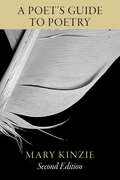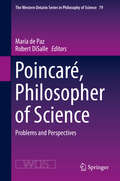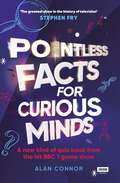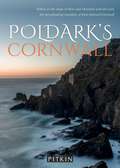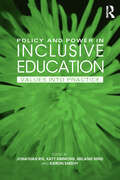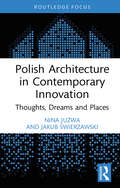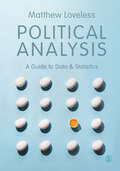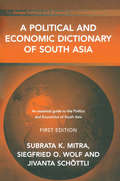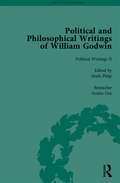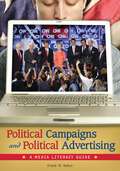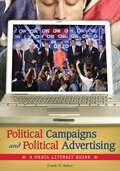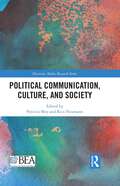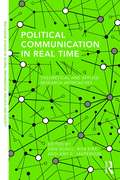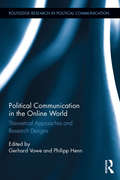- Table View
- List View
A Poet's Guide to Poetry, Second Edition (Chicago Guides to Writing, Editing, and Publishing)
by Mary KinzieIn A Poet’s Guide to Poetry, Mary Kinzie brings her decades of expertise as poet, critic, and director of the creative writing program at Northwestern University to bear in a comprehensive reference work for any writer wishing to better understand poetry. Detailing the formal concepts of poetry and methods of poetic analysis, she shows how the craft of writing can guide the art of reading poems. Using examples from the major traditions of lyric and meditative poetry in English from the medieval period to the present, Kinzie considers the sounds and rhythms of poetry along with the ideas and thought-units within poems. Kinzie also shares her own successful classroom tactics that encourage readers to approach a poem as if it were provisional. The three parts of A Poet’s Guide to Poetry lead the reader through a carefully planned introduction to the ways we understand poetry. The first section provides careful, step-by-step instruction to familiarize students with the formal elements of poems, from the most obvious feature through the most subtle. The second part carefully examines meter and rhythm, as well as providing a theoretical and practical overview of free verse. The final section offers helpful chapters on writing in form. Rounding out the volume are writing exercises for beginning and advanced writers, a dictionary of poetic terms, and a bibliography of further reading. For this new edition, Kinzie has carefully reworked the introductory material and first chapter, as well as amended the annotated bibliography to include the most recent works of criticism. The updated guide also contains revised exercises and adjustments throughout the text to make the work as lucid and accessible as possible.
Poincaré, Philosopher of Science: Problems and Perspectives (The Western Ontario Series in Philosophy of Science #79)
by María De Paz Robert DiSalleThis volume presents a selection of papers from the Poincaré Project of the Center for the Philosophy of Science, University of Lisbon, bringing together an international group of scholars with new assessments of Henri Poincaré's philosophy of science—both its historical impact on the foundations of science and mathematics, and its relevance to contemporary philosophical inquiry. The work of Poincaré (1854-1912) extends over many fields within mathematics and mathematical physics. But his scientific work was inseparable from his groundbreaking philosophical reflections, and the scientific ferment in which he participated was inseparable from the philosophical controversies in which he played a pre-eminent part. The subsequent history of the mathematical sciences was profoundly influenced by Poincaré’s philosophical analyses of the relations between and among mathematics, logic, and physics, and, more generally, the relations between formal structures and the world of experience. The papers in this collection illuminate Poincaré’s place within his own historical context as well as the implications of his work for ours.
Pointless Facts for Curious Minds: A new kind of quiz book from the hit BBC 1 game show
by Alan ConnorWhich star of The Crown is the great-granddaughter of a British prime minister?Which TV quiz show is based on the creator's experience of being interrogated as a prisoner of war?Which property on the Monopoly board does not exist in the real-life London?For lovers of the most obscure and unlikely facts - as well as the unsung quizzing geniuses out there (we all know a couple) - comes Pointless Facts for Curious Minds, the book where obvious answers mean nothing and obscurity reigns. A compendium of fascinating and arcane bits of knowledge, mixed amongst a healthy dose of Pointless quizzing, this is a book that takes a quiz as only the starting point of your intelligent adventures.Pointless Facts for Curious Minds gives you the chance to put your knowledge to the test and prove your Pointless credentials.
Points of View in the Modern History of Psychology
by Claude E. BuxtonPoints of View in the Modern History of Psychology is a collection of papers that presents each individual contributor's expert knowledge of history in the field of psychology. One paper examines Wilhelm Wundt's concept of psychology as the propaedeutic science surviving and inspiring a generation or more of psychologists. Another paper discusses the early sources and the basic conceptions of functionalism as used in America. John B. Watson proclaims behaviorism as a new discipline in psychology with defining features, such as an objective, deterministic, scientific, and experimental method that can be used in both human and animal studies. Lieberman (1979), Mackenzie (1977) Miller, Galanter, and Pribram (1960) oppose behaviorism on the grounds that it slights the purpose of psychology, and focuses more on methodology to the detriment of theory. One paper notes that the acceptance or influence that a point of view has is based in some ways on the range and clarity of its connections with experimental and observational reality. This collection can prove useful for psychologists, behavioral scientists, psychiatrists, psycho-analysts, students of psychology, philosophy or general history who are interested in the many viewpoints of psychology.
Poldark's Cornwall (Location Guides #5)
by Gill KnappettAre you longing to know where your favourite scenes in Poldark were filmed? Or discover the secrets behind the derelict mines and perfect, unspoiled beaches? Pitkin's latest addition to the Film Locations series allows you the inside knowledge to go behind the scenes and follow in the footsteps of Ross and Demelza. Travel back in time and join them along the windswept cliffs, rugged coastline and untouched, pristine beaches. From Padstow to the Lizard peninsula, Cornwall takes centre stage, providing the breath-taking backdrop that brings the series to life. The latest awarding-winning adaptation of Winston Graham's Poldark, produced by the BBC, has captured the hearts of millions of viewers worldwide. As the third series returns to our screens this summer, and with a forth series underway, tourists from all over the globe are flocking to the deepest corners of the UK's southwestern tip. Over the last three years the series has brought the region's rich heritage back to life, with tales of smugglers, shipwrecks and the secrets of the mines gripping viewer's imaginations. Visit the Poldark family mines at Agnes Head or Levant Mine, a World Heritage Site. Gallop along the clifftops of Chapel Porth, and learn of famous shipwrecks at Gunwalloe. If it's the glistening, azur waters you're after, don't miss Holywell Bay, Cornwall's largest stretch of coastline, which becomes the Warleggans private beach in series two. Cornwall has been an inspiration for writer's, film directors and artists alike for centuries, and Eleanor Tomlinson (Demelza) sums up its magic. "So much of the piece came alive when we were filming in Cornwall and everyone found their character in the outdoors." Britain's best kept secret is yours to enjoy.
Policy and Power in Inclusive Education: Values into practice
by Melanie Nind Jonathan Rix Kieron Sheehy Katy SimmonsThe movement towards inclusive education is undoubtedly an international phenomenon, and it has resulted in the development of policy initiatives impacting on schools in all nations. This informative, wide-ranging text brings together key illustrative material from an international field. It adopts a critical perspective on policy issues, but goes beyond this by making explicit the assumptions that drive policy development. Readers will be encouraged to develop their own framework, allowing them to conduct policy analysis and evaluation within their own educational context.Students and researchers interested in how principles of inclusive education are being translated into educational practices around the world will find this book an enlightening read.
Policy and Power in Inclusive Education: Values into practice
by Jonathan Rix Katy Simmons Melanie Nind Kieron SheehyThe movement towards inclusive education is undoubtedly an international phenomenon, and it has resulted in the development of policy initiatives impacting on schools in all nations. This informative, wide-ranging text brings together key illustrative material from an international field. It adopts a critical perspective on policy issues, but goes beyond this by making explicit the assumptions that drive policy development. Readers will be encouraged to develop their own framework, allowing them to conduct policy analysis and evaluation within their own educational context.Students and researchers interested in how principles of inclusive education are being translated into educational practices around the world will find this book an enlightening read.
Policy Reform in Developing Countries
by Bela BalassaPolicy Reform in Developing Countries deals with questions of policy reforms in selected countries. This book is a collection of essays describing the application of general principles of policy reforms made in countries with an industrial base, such as Mexico, Portugal, Venezuela, Chile, the Andean Common Market, Egypt, and Korea. Through these essays, the author evaluates the general principles that make up desirable policy reforms in these countries, and describes the application of these principles in various actual situations. One essay presents the reforms needed to improve the system of incentives, which include credit, labor market, and public utility pricing. For example, this book analyzes the tariff reform proposed in Chile and the guidelines for the common external tariff used in the Andean Common Market. Another essay evaluates the role of the manufacturing sector in the economic growth of Portugal, and recommends other strategies for this sector. This book then recommends proposals in the development strategy of Korea for the Fourth Five-Year Plan Period, while one other essay reviews the system of incentives that will serve the objectives of the Fourth Five-Year Plan of this country. This collection of essays is suitable for economic planners, heads of state ministries, academic and non-profit institutions dealing with developmental planning, and students and professors in history and political science.
Polish Architecture in Contemporary Innovation: Thoughts, Dreams and Places
by Nina Juzwa Jakub ŚwierzawskiAuthored by two architects, Polish Architecture in Contemporary Innovation: Thoughts, Dreams and Places tells a story of buildings that were built in Poland between 1980 and 2020, as architecture developed in the Western world and Japan. Its main focus is public utility buildings which the authors “have touched” in situ and which have moved them or sparked their interest. The book is divided into three parts: • Part I focuses on the problem of creating and shaping architectural form and uses examples of both international and Polish architecture. In this section, the authors pose the question: why is the Pritzker Prize so important? • Part II attempts to answer the question of how architecture can change the image of a place. The answer consists of mainly Polish examples of user-friendly architecture, value, and beauty in architecture and place. • Part III analyses buildings that were created in contemporary Poland. Examples are listed in groups, according to their function, pointing out forms that were inspired by the culture of the region, the historical culture of the place, or those which are a new quality and are the foundation of the creation of a place. This book aims to demonstrate Polish architectural solutions in the context of contemporary trends in the West, traditionally seen as more technically and technologically developed countries. The floor plans and sections of the buildings presented in the book show the beauty of geometric and formal solutions and give a new and rare perspective on the latest changes in modern Polish architecture. This book will be of interest to architects as well as researchers and students of contemporary Polish architecture and culture and its place in the European and international context. The Polish edition of this book, published in 2021 by the National Institute of Architecture and Urban Planning in Warsaw, received the Vitruvius Prize 2022 by the Architecture and Urban Planning Committee of the Polish Academy of Sciences.
Polish Architecture in Contemporary Innovation: Thoughts, Dreams and Places
by Nina Juzwa Jakub ŚwierzawskiAuthored by two architects, Polish Architecture in Contemporary Innovation: Thoughts, Dreams and Places tells a story of buildings that were built in Poland between 1980 and 2020, as architecture developed in the Western world and Japan. Its main focus is public utility buildings which the authors “have touched” in situ and which have moved them or sparked their interest. The book is divided into three parts: • Part I focuses on the problem of creating and shaping architectural form and uses examples of both international and Polish architecture. In this section, the authors pose the question: why is the Pritzker Prize so important? • Part II attempts to answer the question of how architecture can change the image of a place. The answer consists of mainly Polish examples of user-friendly architecture, value, and beauty in architecture and place. • Part III analyses buildings that were created in contemporary Poland. Examples are listed in groups, according to their function, pointing out forms that were inspired by the culture of the region, the historical culture of the place, or those which are a new quality and are the foundation of the creation of a place. This book aims to demonstrate Polish architectural solutions in the context of contemporary trends in the West, traditionally seen as more technically and technologically developed countries. The floor plans and sections of the buildings presented in the book show the beauty of geometric and formal solutions and give a new and rare perspective on the latest changes in modern Polish architecture. This book will be of interest to architects as well as researchers and students of contemporary Polish architecture and culture and its place in the European and international context. The Polish edition of this book, published in 2021 by the National Institute of Architecture and Urban Planning in Warsaw, received the Vitruvius Prize 2022 by the Architecture and Urban Planning Committee of the Polish Academy of Sciences.
Political Analysis: A Guide to Data and Statistics
by Matthew LovelessWhy let other people explain the world to you? From news reporting on elections or unfolding political crises to everyday advertising, you are confronted with statistics. Rather than being swayed by bad arguments and questionable correlations, this book introduces you to the most common and contemporary statistical methods so that you can better understand the world. It′s not about mindless number crunching or flashy techniques but about knowing when to use statistics as the best means to analyse a problem. Whether you want to answer: "Who is most likely to turn out and vote at the next election?" or "What accounts for some political conflicts escalating to war?" you’ll explore what can and can’t be done with statistics, and how to select the most appropriate statistical techniques and correctly interpret the results. Perhaps you simply want to understand enough to pass your statistics class and move on. Maybe you want to build your knowledge so that you are not excluded from research and debate. Or it could be the first step towards more advanced study. Whatever your goal, this book guides you through the journey, empowering you to confidently interact with statistics to make you a more formidable student, employee, and democratic citizen.
Political Analysis: A Guide to Data and Statistics
by Matthew LovelessWhy let other people explain the world to you? From news reporting on elections or unfolding political crises to everyday advertising, you are confronted with statistics. Rather than being swayed by bad arguments and questionable correlations, this book introduces you to the most common and contemporary statistical methods so that you can better understand the world. It′s not about mindless number crunching or flashy techniques but about knowing when to use statistics as the best means to analyse a problem. Whether you want to answer: "Who is most likely to turn out and vote at the next election?" or "What accounts for some political conflicts escalating to war?" you’ll explore what can and can’t be done with statistics, and how to select the most appropriate statistical techniques and correctly interpret the results. Perhaps you simply want to understand enough to pass your statistics class and move on. Maybe you want to build your knowledge so that you are not excluded from research and debate. Or it could be the first step towards more advanced study. Whatever your goal, this book guides you through the journey, empowering you to confidently interact with statistics to make you a more formidable student, employee, and democratic citizen.
Political Analysis: A Guide to Data and Statistics
by Matthew LovelessWhy let other people explain the world to you? From news reporting on elections or unfolding political crises to everyday advertising, you are confronted with statistics. Rather than being swayed by bad arguments and questionable correlations, this book introduces you to the most common and contemporary statistical methods so that you can better understand the world. It′s not about mindless number crunching or flashy techniques but about knowing when to use statistics as the best means to analyse a problem. Whether you want to answer: "Who is most likely to turn out and vote at the next election?" or "What accounts for some political conflicts escalating to war?" you’ll explore what can and can’t be done with statistics, and how to select the most appropriate statistical techniques and correctly interpret the results. Perhaps you simply want to understand enough to pass your statistics class and move on. Maybe you want to build your knowledge so that you are not excluded from research and debate. Or it could be the first step towards more advanced study. Whatever your goal, this book guides you through the journey, empowering you to confidently interact with statistics to make you a more formidable student, employee, and democratic citizen.
A Political and Economic Dictionary of South Asia
by Jivanta Schottli Subrata K. Mitra Siegried WolfThanks to its emerging markets, nuclearization and the internet revolution, South Asia is increasingly at the forefront of current affairs. This invaluable reference source seeks to make the region accessible to business travellers as well as to the general reader. The range of subjects to be covered includes major political processes and events of South Asia (elections and electoral politics, political slang, political parties, diplomacy and territorial divisions), domestic and foreign policy, key personalities, political and economic institutions, sub-national groupings and units (regions, cities, provinces and rural entities), ethnicity and identity, and legal systems (laws and court cases). Key features: * Terms, which are frequently misunderstood in the political and economic processes of South Asia, are explained clearly and succinctly * More than 1,000 entries, covering the key debates, issues, concepts and institutions. Entries include: Bharatiya Janata Party (BJP), Caste System, Corruption, dalits, Electoral System, Federalism, Hindu-Muslim relation, India-US Relation, Kashmir, Liberation Tigers of Tamil Eelam (LTTE), Nuclearization, Privatization, Reserve Bank of India, Sikh, Untouchability, Urbanization, Atal Behari Vajpayee. Countries covered in this volume include: Bangladesh, Bhutan, India, Maldives, Nepal, Pakistan and Sri Lanka.
A Political and Economic Dictionary of South Asia
by Jivanta Schottli Subrata K. Mitra Siegried WolfThanks to its emerging markets, nuclearization and the internet revolution, South Asia is increasingly at the forefront of current affairs. This invaluable reference source seeks to make the region accessible to business travellers as well as to the general reader. The range of subjects to be covered includes major political processes and events of South Asia (elections and electoral politics, political slang, political parties, diplomacy and territorial divisions), domestic and foreign policy, key personalities, political and economic institutions, sub-national groupings and units (regions, cities, provinces and rural entities), ethnicity and identity, and legal systems (laws and court cases). Key features: * Terms, which are frequently misunderstood in the political and economic processes of South Asia, are explained clearly and succinctly * More than 1,000 entries, covering the key debates, issues, concepts and institutions. Entries include: Bharatiya Janata Party (BJP), Caste System, Corruption, dalits, Electoral System, Federalism, Hindu-Muslim relation, India-US Relation, Kashmir, Liberation Tigers of Tamil Eelam (LTTE), Nuclearization, Privatization, Reserve Bank of India, Sikh, Untouchability, Urbanization, Atal Behari Vajpayee. Countries covered in this volume include: Bangladesh, Bhutan, India, Maldives, Nepal, Pakistan and Sri Lanka.
The Political and Philosophical Writings of William Godwin vol 2
by Mark Philp Pamela Clemit Martin Fitzpatrick William St.ClairContains all the major political, philosophical and educational writings of William Godwin, one of the foremost philosophers of his age. His work on government and individual freedom, "Political Justice", made him the chief exponent of English radicalism in the latter half of the 18th century.
The Political and Philosophical Writings of William Godwin vol 2
by Mark Philp Pamela Clemit Martin Fitzpatrick William St.ClairContains all the major political, philosophical and educational writings of William Godwin, one of the foremost philosophers of his age. His work on government and individual freedom, "Political Justice", made him the chief exponent of English radicalism in the latter half of the 18th century.
Political Campaigns and Political Advertising: A Media Literacy Guide
by Frank W. BakerExamining political campaigns and political advertising through the analytical lens of media literacy, this well-illustrated and timely handbook guides readers through the maze of blandishments and spin that is the hallmark of the modern political campaign. It dissects the persuasive strategies embedded in the political messages we encounter every day in the media and demonstrates the importance of critical thinking in evaluating media stories. Key concepts of media literacy are applied to political advertising in traditional media (newspapers, television, radio) and on the Internet, the new frontier of the political advertising wars. Dealing with blogs, social networking, user-generated Web sites, and other electronic formats familiar to young voters, this lively introduction to the new world of political messaging appeals to readers' affinity for visual learning as well as their ability to discern messages in text.Unique in applying media literacy concepts to the political context while directly addressing students and general readers, this book not only explains but graphically demonstrates both established techniques of political framing and the new avenues of persuasion being pioneered in digital media. It will also interest viewers who like their political news in traditional media but unconventional formats.
Political Campaigns and Political Advertising: A Media Literacy Guide
by Frank W. BakerExamining political campaigns and political advertising through the analytical lens of media literacy, this well-illustrated and timely handbook guides readers through the maze of blandishments and spin that is the hallmark of the modern political campaign. It dissects the persuasive strategies embedded in the political messages we encounter every day in the media and demonstrates the importance of critical thinking in evaluating media stories. Key concepts of media literacy are applied to political advertising in traditional media (newspapers, television, radio) and on the Internet, the new frontier of the political advertising wars. Dealing with blogs, social networking, user-generated Web sites, and other electronic formats familiar to young voters, this lively introduction to the new world of political messaging appeals to readers' affinity for visual learning as well as their ability to discern messages in text.Unique in applying media literacy concepts to the political context while directly addressing students and general readers, this book not only explains but graphically demonstrates both established techniques of political framing and the new avenues of persuasion being pioneered in digital media. It will also interest viewers who like their political news in traditional media but unconventional formats.
Political Communication, Culture, and Society (ISSN)
by Patricia Moy Rico NeumannAs an installment of Routledge’s Broadcast Education Association (BEA) Electronic Media Research Series, Political Communication, Culture, and Society focuses on the expansive concept of political communication and illuminates the processes, contents, and effects related to myriad forms and vehicles of political communication. Whether involving traditional print or broadcast media, social media platforms, or face-to-face discussions, political communication today has shaped how we perceive others and understand the world around us, including our place in it, and ultimately, how we engage with others as social, cultural, and political beings.Hailing from multiple locations and drawing on a multitude of theories as well as quantitative and qualitative methodologies, the volume’s contributors examine how communication intersects with politics in a broad swath of contexts, ranging from climate change to migration to the notion of political correctness. Collectively they ask and answer questions about how today’s richly textured media ecology shapes our political world and how political messages can fuel – and ameliorate – the issues that deeply cleave societies around the globe.Relevant to scholars and students of journalism, media studies, and communication sciences, this volume will help interested readers better understand today’s increasingly complex sociocultural world through the lens of political communication.
Political Communication, Culture, and Society (ISSN)
As an installment of Routledge’s Broadcast Education Association (BEA) Electronic Media Research Series, Political Communication, Culture, and Society focuses on the expansive concept of political communication and illuminates the processes, contents, and effects related to myriad forms and vehicles of political communication. Whether involving traditional print or broadcast media, social media platforms, or face-to-face discussions, political communication today has shaped how we perceive others and understand the world around us, including our place in it, and ultimately, how we engage with others as social, cultural, and political beings.Hailing from multiple locations and drawing on a multitude of theories as well as quantitative and qualitative methodologies, the volume’s contributors examine how communication intersects with politics in a broad swath of contexts, ranging from climate change to migration to the notion of political correctness. Collectively they ask and answer questions about how today’s richly textured media ecology shapes our political world and how political messages can fuel – and ameliorate – the issues that deeply cleave societies around the globe.Relevant to scholars and students of journalism, media studies, and communication sciences, this volume will help interested readers better understand today’s increasingly complex sociocultural world through the lens of political communication.
Political Communication in Real Time: Theoretical and Applied Research Approaches (Routledge Studies in Global Information, Politics and Society)
by Dan Schill Rita Kirk Amy E. JaspersonMuch has been made of the speed and constancy of modern politics. Whether watching cable news, retweeting political posts, or receiving news alerts on our phones, political communication now happens continuously and in real time. Traditional research methods often do not capture this dynamic environment. Early studies that guided the study of political communication took place at a time when transistors and FM radio, television, and widely distributed films technologically changed the way people gained information and developed knowledge of the world around them. Now, the environment has transformed again through digital innovations. This book provides one of the first systematic assessment of real-time methods used to study the new digital media environment. It features twelve chapters—authored by leading researchers in the field—using continuous or real time response methods to study political communication in various forms. Moreover, the authors explain how viewer attitudes can be measured over time, message effects can be pin-pointed down to the second of impact, behaviors can be tracked and analyzed unobtrusively, and respondents can naturally respond on their smartphone, tablet, or even console gaming system. Leading practitioners in the field working for CNN, Microsoft, and Twitter show how the approach is being innovatively used in the field. Political Communication in Real Time is a welcome addition to the growing field of interest in "big data" and continuous response research. This volume will appeal to scholars and practitioners in political science and communication studies wishing to gain new insights into the strengths and limitations of this approach. Political communication is a continuous process, so theories, applications, and cognitive models of such communication require continuous measures and methods.
Political Communication in Real Time: Theoretical and Applied Research Approaches (Routledge Studies in Global Information, Politics and Society)
by Dan Schill Rita Kirk Amy E. JaspersonMuch has been made of the speed and constancy of modern politics. Whether watching cable news, retweeting political posts, or receiving news alerts on our phones, political communication now happens continuously and in real time. Traditional research methods often do not capture this dynamic environment. Early studies that guided the study of political communication took place at a time when transistors and FM radio, television, and widely distributed films technologically changed the way people gained information and developed knowledge of the world around them. Now, the environment has transformed again through digital innovations. This book provides one of the first systematic assessment of real-time methods used to study the new digital media environment. It features twelve chapters—authored by leading researchers in the field—using continuous or real time response methods to study political communication in various forms. Moreover, the authors explain how viewer attitudes can be measured over time, message effects can be pin-pointed down to the second of impact, behaviors can be tracked and analyzed unobtrusively, and respondents can naturally respond on their smartphone, tablet, or even console gaming system. Leading practitioners in the field working for CNN, Microsoft, and Twitter show how the approach is being innovatively used in the field. Political Communication in Real Time is a welcome addition to the growing field of interest in "big data" and continuous response research. This volume will appeal to scholars and practitioners in political science and communication studies wishing to gain new insights into the strengths and limitations of this approach. Political communication is a continuous process, so theories, applications, and cognitive models of such communication require continuous measures and methods.
Political Communication in the Online World: Theoretical Approaches and Research Designs (Routledge Research in Political Communication)
by Gerhard Vowe Philipp HennAs a consequence of the rapid diffusion of online media, the conditions for political communication, and research concerning it have radically changed. Is empirical communication research capable of consistently describing and explaining the changes in political communication in the online world both from a theoretical and methodological perspective? In this book, Gerhard Vowe, Philipp Henn, and a group of leading international experts in the field of communication studies guide the reader through the complexities of political communication, and evaluate whether and to what extent existing theoretical approaches and research designs are relevant to the online world. In the first part of the book, nine chapters offer researchers the opportunity to test the basic assumptions of prominent theories in the field, to specify them in terms of the conditions of political communication in the online world and to modify them in view of the systematically gained experiences. The second methodological section tests the variations of content analysis, surveys, expert interviews and network analyses in an online environment and documents how successful these methods of empirical analysis have proven to be in political communication. Written accessibly and contributing to key debates on political communication, this bookshelf essential presents an indispensable account of the necessary tools needed to allow researchers decide which approach and method is better suited to answer their online problem.
Political Communication in the Online World: Theoretical Approaches and Research Designs (Routledge Research in Political Communication)
by Gerhard Vowe Philipp HennAs a consequence of the rapid diffusion of online media, the conditions for political communication, and research concerning it have radically changed. Is empirical communication research capable of consistently describing and explaining the changes in political communication in the online world both from a theoretical and methodological perspective? In this book, Gerhard Vowe, Philipp Henn, and a group of leading international experts in the field of communication studies guide the reader through the complexities of political communication, and evaluate whether and to what extent existing theoretical approaches and research designs are relevant to the online world. In the first part of the book, nine chapters offer researchers the opportunity to test the basic assumptions of prominent theories in the field, to specify them in terms of the conditions of political communication in the online world and to modify them in view of the systematically gained experiences. The second methodological section tests the variations of content analysis, surveys, expert interviews and network analyses in an online environment and documents how successful these methods of empirical analysis have proven to be in political communication. Written accessibly and contributing to key debates on political communication, this bookshelf essential presents an indispensable account of the necessary tools needed to allow researchers decide which approach and method is better suited to answer their online problem.
